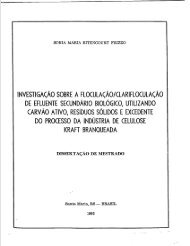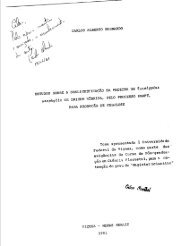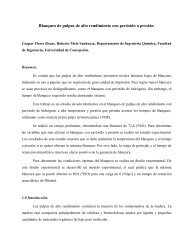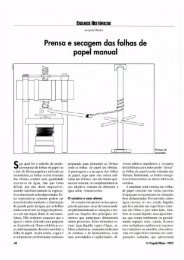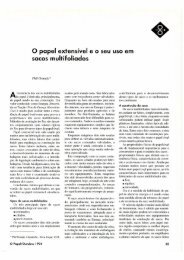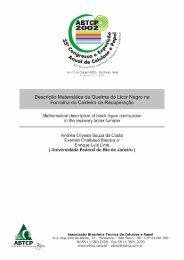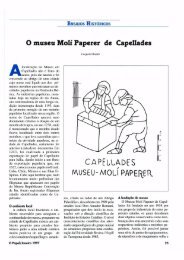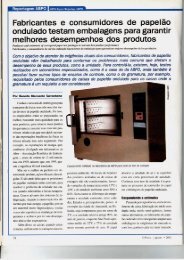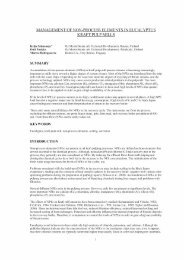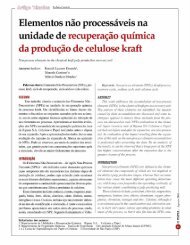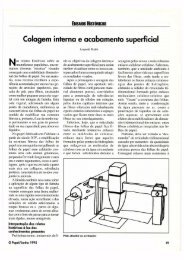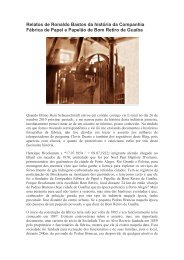O Eucalipto: um século no Brasil (The Eucalypt - Celso Foelkel
O Eucalipto: um século no Brasil (The Eucalypt - Celso Foelkel
O Eucalipto: um século no Brasil (The Eucalypt - Celso Foelkel
You also want an ePaper? Increase the reach of your titles
YUMPU automatically turns print PDFs into web optimized ePapers that Google loves.
As pesquisas de Navarro de Andrade envolvendo o eucalipto começaram em<br />
1903 e, antes mesmo que se encerrassem, em Rio Claro, <strong>no</strong> Interior paulista, o<br />
eucalipto foi pela primeira vez usado em larga escala <strong>no</strong> <strong>Brasil</strong>, na Amazônia.<br />
Quando da construção da ‘Ferrovia da Morte’, em 1907, a Madeira-Mamoré,<br />
o contrato com a empresa May, Jekyll & Randolph previa que os dormentes<br />
fossem conseguidos ‘in loco’, das imensas árvores da floresta amazônica, a <strong>um</strong><br />
custo previsto de 2$000 (dois mil réis). A obra foi extremamente complicada,<br />
engajou 30.000 trabalhadores vindos de vários países, dos quais 6.000 faleceram<br />
na mata, devido à malária, principalmente.<br />
O corte da madeira até que não era difícil, mas a secagem, o corte <strong>no</strong> formato<br />
de dormente e o transporte pela selva sem caminhos se mostraram tão complicados,<br />
que o custo logo se elevou a 20$000 por dormente pronto para receber<br />
os trilhos. O valor era tão alto, que os construtores ingleses consultaram a<br />
Austrália e decidiram que, <strong>no</strong> meio da Amazônia tão rica em árvores, seria mais<br />
barato trazer dormentes do outro lado do mundo, feitos de eucalipto, é claro.<br />
Cada dormente australia<strong>no</strong> custou 6$000.<br />
Navarro de Andrade não usou esse arg<strong>um</strong>ento, porém. Estava tão convencido<br />
das vantagens do eucalipto sobre as outras essências, nativas ou não, que em<br />
1908 informou à diretoria da Companhia Paulista de Estradas de Ferro que o<br />
eucalipto era a solução para as necessidades da ferrovia. Um <strong>século</strong> depois, a<br />
escolha permanece.<br />
O E U C A L I P T O - U M S É C U L O N O B R A S I L<br />
60<br />
Dormentes da Austrália<br />
Sleepers from Australia<br />
Navarro de Andrade’s started his research on eucalypt in 1903 and, even before they<br />
had been wrapped-up, in Rio Claro, in the Interior of the State of São Paulo, eucalypt<br />
had been used on the large scale for the first time in Brazil, in the Amazon region.<br />
During the ‘Death Railway’ construction, in 1907, the Madeira-Mamoré,<br />
the agreement signed with May, Jekyll & Randolph Co. required the sleepers<br />
be obtained ‘in loco,’ from the huge Amazon forest trees, at a cost foreseen<br />
at 2$000 (two thousand Réis). <strong>The</strong> work was extremely complex, however,<br />
involved 30,000 workers coming from several countries, 6,000 of whom died<br />
in the forest, especially from malaria.<br />
It was <strong>no</strong>t hard to cut the trees, but drying it, shaping and cutting in the shape<br />
of sleepers and transporting it through the forest without trails revealed to<br />
be such a complex task that the cost soon rose to 20$000 per sleeper ready to<br />
receive the tracks. <strong>The</strong> value was so high that English constructors contacted<br />
Australia and decided that in the middle of the Amazon, so rich in trees, it<br />
would be cheaper to bring sleepers half the way around the world, made out<br />
of eucalypt, of course. Each Australian sleeper costed 6$000.<br />
Navarro de Andrade didn’t use this arg<strong>um</strong>ent, though. He was so convinced<br />
of the advantages brought by eucalypt compared to other genus, whether or<br />
<strong>no</strong>t native, that in 1908 he informed the board of the Companhia Paulista<br />
de Estradas de Ferro that eucalypt was the solution for the railway’s needs. A<br />
century later, the choice remains.




